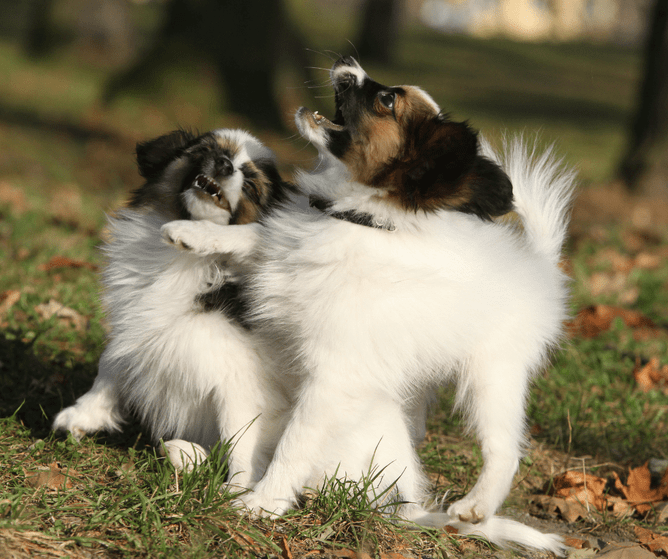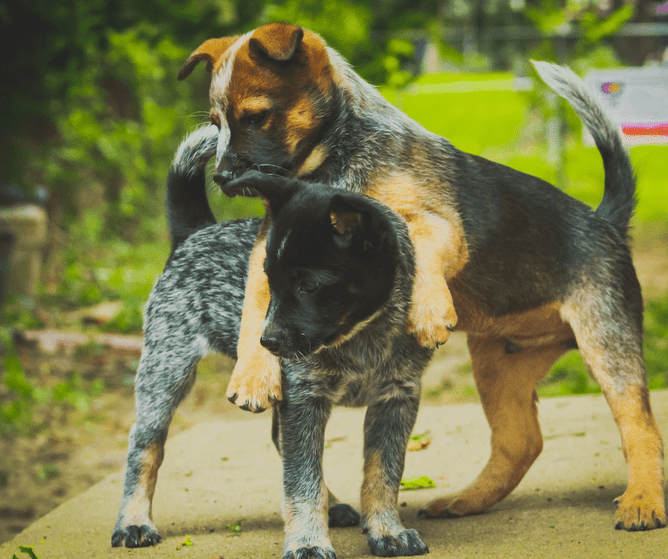Puppy Play
Puppies playing nicely together is almost guaranteed to put a smile on your face. What puppies learn in their early stages of their life has a big impact on their lives as adults, and learning to interact calmly and safely with other dogs is important.
We also know that preferences and tolerance levels change throughout life and sometimes over a short space of time (e.g. from puppy to adolescence).
Play styles can also vary and while one style may work for some puppies, it may not work for another. Teaching puppies to adjust their play style can take some time.
What is good play? ✅ 💚
Relaxed body language – look at the tail, ears, mouth, and whole body. Relaxed play looks fluid, can be bouncy and you may see play bows.
Role reversals and taking turns – I chase you; you chase me. I jump on you; you jump on me.
Self-handicapping – for example a larger or more confident puppy makes itself lower/smaller to play with a smaller or less confident puppy.
Regular natural play breaks. These are when one or both puppies has a drink, starts sniffing, or walks away and it signals to other puppies they need a break. Some puppies don’t know how to read this so it’s up to us to step in to help some puppies understand.
Bitey face games. You may see baring teeth and vocalisation and often the teeth can clash. This is play provided the body is relaxed, however listen for changes in intensity of vocalisation or teeth clashing and changes in body language such as harder eyes and tail position.
Interrupt or not? Continue to watch closely – you may need to interrupt. 🧡❓
Body language such as lip licking, head turns/look aways, moving slower or stillness can mean another puppy is trying to indicate it needs a break. Puppies can’t always effectively read these signals, but we can help teach them.
If one puppy is always on its back. Gently redirect the puppy on top to allow the puppy on its back a chance to get up. Once it gets up and goes straight back to the other puppy or onto it’s back again you can allow it but keep monitoring and watching body language.
Puppy teeth are needle sharp for good reasons, and it can teach puppies ‘bite inhibition’ if they use their teeth too enthusiastically. If they bite too hard and another puppy vocalises, they can learn to inhibit their bite (oops sorry! Too hard, I’ll be more gentle next time) – but it needs to be guided as vocalisation can often cause over arousal for some puppies. So, monitor and interrupt if needed.
Both puppies rearing up on hind legs. This is usually related to arousal level but can be about taking control. It should be redirected as it often isn’t appropriate and can increase arousal further.
Vocalisation intensifies and sounds different or more intense.
Barking at each other in each other’s faces. Read body language as it may be conflicted, and a puppy may be unsure.
If you are unsure to interrupt or not, it’s usually best to interrupt to help reduce arousal levels and then allow play to resume after a short break.
You must interrupt ❌❗
Fearful or stressed body language such as tucked tail, backing away, stiff body, bearing teeth/growling and avoidance/hiding away from other puppies.
Arousal and intensity levels increase out of one or both puppies comfort zones.
If a puppy yelps or vocalises in a non-playful way.
Body slamming with a stiff body.
Biting, or grabbing body parts roughly.
One sided play (all the time).
We include carefully supervised puppy play/interactions in our puppy classes for several reasons:
1. To teach puppy parents what to look for and when to interrupt.
2. To introduce puppies to safe and calm proximity to other puppies.
3. To teach puppies appropriate interactions.
If you need help reading and interpreting your dog’s body language or assistance with dog training, get in touch today.


